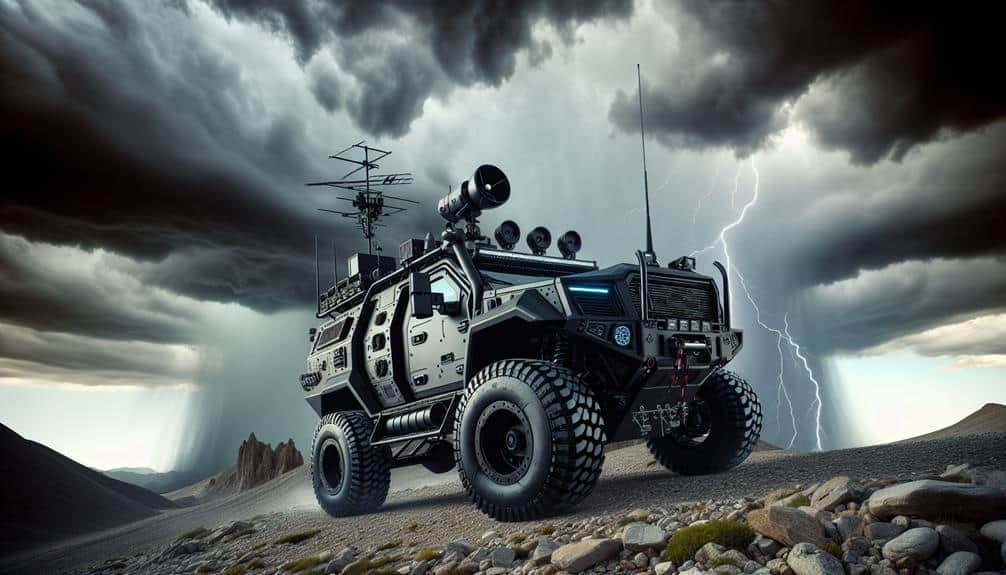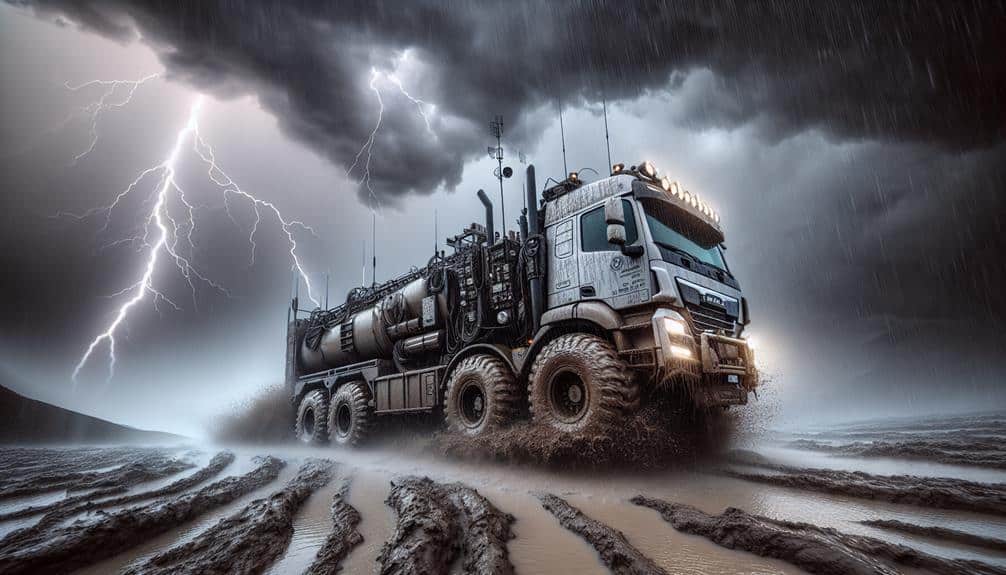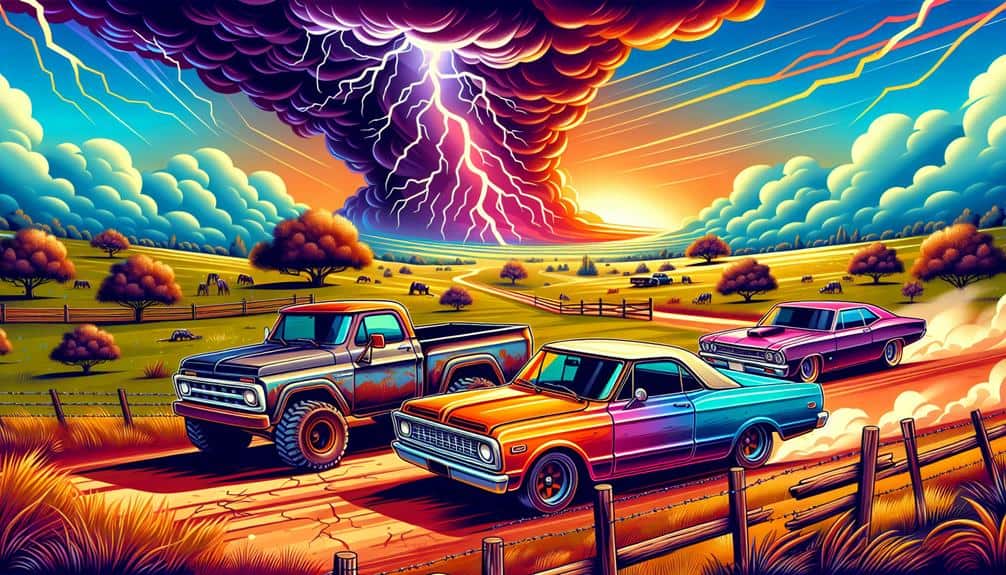We need to equip our storm-chasing SUVs with top-notch exterior lighting options that combine durability, energy efficiency, and high-performance illumination. LED light bars provide superior lumen output and resilience, mimicking daylight with around 6000K light. Spotlights offer long-range brightness with adjustable mounts, while floodlights ensure wide area coverage with wide beam angles. Strobe lights, with their intense bursts, cut through severe weather, and fog lights enhance visibility in low conditions. Work lights provide focused beams for nighttime tasks, and underbody lights illuminate hazards below. Let’s explore these options in depth for best storm-chasing readiness.
Key Points
- LED light bars offer superior illumination, durability, and energy efficiency, ideal for diverse storm chasing scenarios.
- Spotlights provide exceptional brightness and range, ensuring visibility during severe weather conditions.
- Floodlights cover broad areas with intense beams, essential for large-scale illumination in challenging environments.
- Fog lights enhance visibility in adverse weather, cutting through fog, rain, and snow with broad, low-lying beams.
LED Light Bars
LED light bars are an important upgrade for storm chasing SUVs, providing superior illumination and durability compared to traditional halogen lights. Let’s delve into the technical specifics.
First, the light beam angles of LED bars are essential. They often feature a combination of flood and spot beams, maximizing both wide-area visibility and long-distance focus. This dual-beam setup ensures we can see obstacles and weather patterns clearly, regardless of the environment.
When considering power consumption, LEDs stand out. They draw significantly less power while delivering high lumen output, preserving our vehicle’s battery life during extended chases. This efficiency is crucial when we’re far from any power sources, allowing us to stay operational longer.
Color temperature plays a notable role in visibility. LED light bars typically emit a bright white light around 6000K, closely mimicking daylight. This color temperature reduces eye strain and enhances contrast, allowing us to distinguish details even in the most challenging conditions.
Spotlights
When it comes to spotlights, we need to assess their brightness and range for peak visibility in severe weather conditions.
We should also assess their durability and weatherproofing to withstand harsh elements.
Brightness and Range
Spotlights offer exceptional brightness and range, allowing storm chasers to illuminate distant objects and navigate through unpredictable weather conditions with greater precision.
When discussing beam intensity, it’s important to take into account lumens and candela ratings. Higher lumens guarantee a wider, more intense light, while candela measures the peak beam intensity, essential for long-distance visibility.
Battery life is another crucial factor; extended duration ensures we aren’t left in the dark during pivotal moments. Spotlights with energy-efficient LEDs often offer the best balance between power consumption and longevity.
Color temperature plays a crucial role in visibility and eye strain. Cooler temperatures (5000K-6000K) mimic daylight, providing sharper contrast and better visibility in stormy conditions.
However, a mixed beam pattern combining spot and flood can greatly enhance our situational awareness, allowing us to see both distant objects and the immediate surroundings simultaneously.
Choosing the right spotlight means balancing these factors. High beam intensity and proper color temperature ensure maximum clarity, while efficient battery life keeps us operational longer.
Durability and Weatherproofing
Securing our spotlights are constructed to withstand the harsh elements is vital, as durability and weatherproofing directly impact their reliability during severe storm conditions. We need spotlights that can endure torrential rain, high winds, and flying debris without faltering. Waterproofing methods are essential here. High-quality silicone seals and gaskets protect internal components from moisture ingress, while IP67 or higher ratings guarantee resistance against water immersion.
Equally important is impact resistance. Our spotlights must withstand impacts from hail, rocks, and other debris without compromising functionality. The use of polycarbonate lenses and sturdy aluminum housings can greatly enhance durability. These materials not only resist cracking but also dissipate heat efficiently, preventing overheating and maintaining consistent performance.
Furthermore, anti-corrosion treatments, such as anodizing or powder coating, provide an additional layer of protection against the elements, extending the lifespan of our lights.
Mounting Options
Choosing the best mounting options for our spotlights guarantees stability and versatility in different storm-chasing situations. We need to make sure our lights remain secure and functional, regardless of the harsh weather conditions we might encounter.
Here’s a detailed analysis of the top mounting options:
- Roof Mounts: These provide a high vantage point, offering a broader illumination range. Roof mounts are ideal for maximizing visibility, especially when maneuvering through unpredictable terrains. They’re also less susceptible to mud and debris compared to lower mounts.
- Grille Mounts: Positioned on the vehicle’s front grille, these mounts are perfect for forward-facing illumination. Grille mounts are excellent for piercing through heavy rainfall and fog, making sure we’ve a clear path ahead. They’re also easier to install and adjust as needed.
- Bumper Mounts: These mounts provide a low-angle beam, useful for close-range visibility. They’re particularly beneficial for identifying obstacles directly in our path. The downside is they can be more exposed to debris.
- A-Pillar Mounts: Located near the windshield, A-pillar mounts offer a balance between roof and grille mounts. They provide a focused beam without compromising the vehicle’s aerodynamics. These mounts are less common but highly effective in targeted lighting.
Floodlights
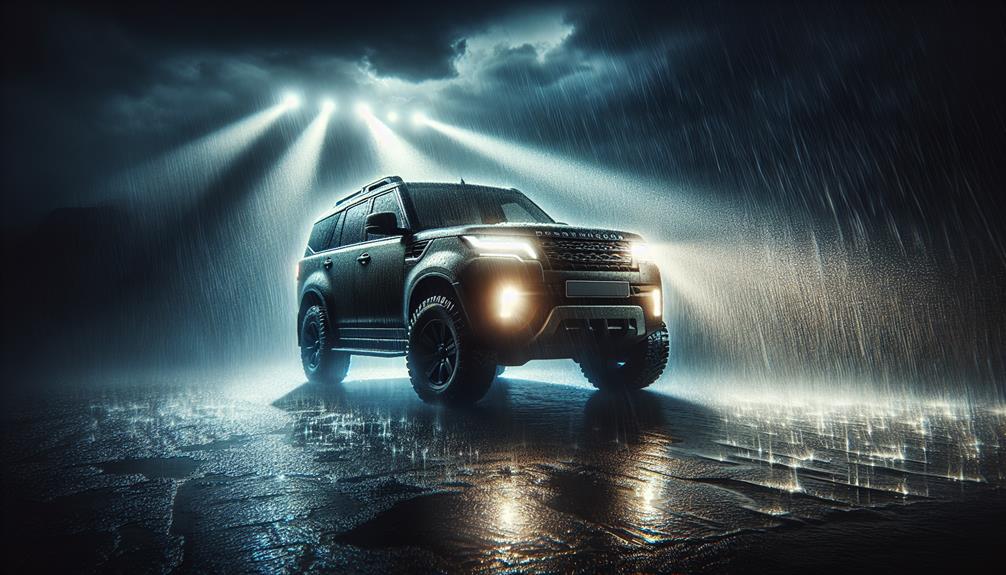
Floodlights provide a broad and intense beam, making them essential for illuminating large areas during severe weather conditions. When we’re out in the field, the wide beam angles of floodlights offer unparalleled versatility, allowing us to cover expansive zones without the need for multiple light sources. This is important when every second counts, and we need to identify and respond to evolving weather patterns quickly.
The color temperature of these floodlights plays a pivotal role in visibility. We typically opt for a cool white color temperature, around 6000K, as it closely mimics daylight and ensures maximum clarity. This helps us discern details that might otherwise be overlooked under poor lighting conditions.
Energy efficiency can’t be overlooked either. LED floodlights are our go-to, as they provide high lumen output with minimal power consumption, allowing us to keep our SUVs running longer without draining the battery. These lights also have a longer lifespan, reducing the need for frequent replacements and thereby ensuring that we’re always prepared for the next storm.
Strobe Lights
Strobe lights serve as an essential tool for storm chasers, providing intense bursts of illumination that can cut through heavy rain, fog, and other severe weather conditions to enhance visibility and safety. When we’re out chasing storms, the right strobe lights can make a world of difference. These lights come with a variety of color options and flash patterns, allowing us to customize them based on our specific needs and preferences. The ability to switch between different modes can be vital when conditions change rapidly.
Synchronization and controls are key features to look for in strobe lights. Advanced systems allow us to synchronize multiple strobe units, guaranteeing a cohesive and effective visual signal. This is particularly useful when coordinating with other storm chasers or emergency vehicles. Modern control units offer intuitive interfaces, making it easy to adjust settings on the fly.
Here are the top considerations for selecting strobe lights:
- Color Options: Choose between amber, white, blue, or red based on visibility and local regulations.
- Flash Patterns: Multiple patterns like single, double, and triple flashes enhance adaptability.
- Synchronization: Ensure all lights flash in unison for maximum impact.
- Controls: User-friendly interfaces for quick adjustments in the field.
These features guarantee we’re well-equipped to handle any storm scenario.
Fog Lights
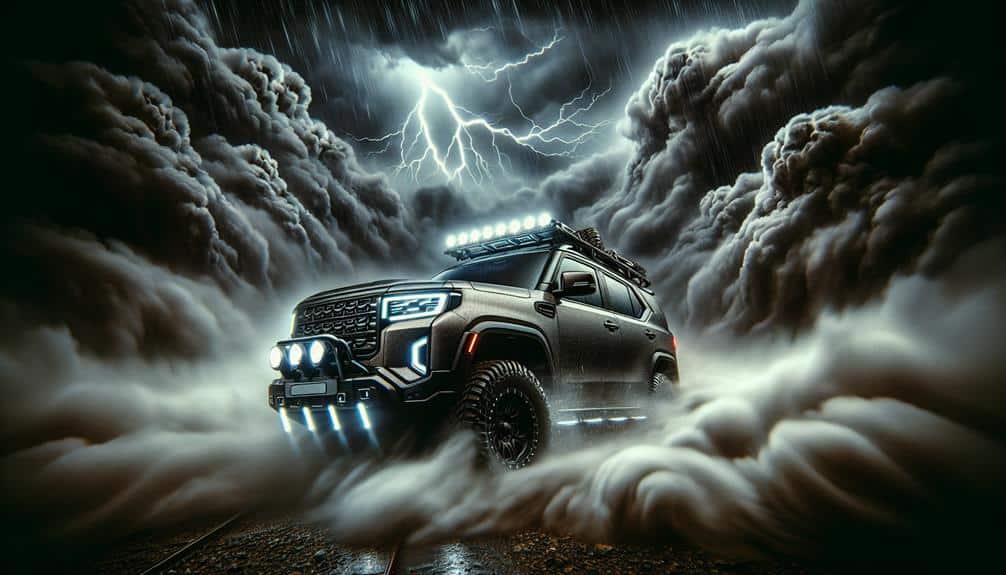
In addition to strobe lights, fog lights play an essential role in enhancing our visibility during storm chases. They cut through dense fog, heavy rain, and snow with a broad, low beam pattern. The primary fog light benefits lie in their ability to project light at a sharp angle, minimizing reflections and glare off water droplets or snowflakes. This ensures we maintain clear sightlines in adverse conditions.
When it comes to fog light installation, precision is key. Proper alignment ensures the beam reaches the best distance without dazzling oncoming drivers. Typically, mounting these lights low on the vehicle’s front bumper optimizes their effectiveness. It’s important to choose high-quality, weather-resistant units to withstand the harsh environments we encounter.
Fog light maintenance is equally significant. Regularly checking for lens clarity and bulb integrity ensures peak performance. Additionally, customization options, such as choosing between halogen, HID, or LED bulbs, allow us to tailor our setup to specific needs and preferences. LEDs, for example, provide superior brightness and longevity, though they may come at a higher initial cost.
Work Lights
Work lights, essential for illuminating our immediate surroundings during nighttime operations, provide a focused and adjustable beam that enhances our ability to conduct repairs and assess storm damage efficiently. When we’re out chasing storms, the right work lights can make a significant difference in visibility and safety.
Let’s explore the key aspects:
- Mounting locations: Strategic placement of work lights is important. Options include roof racks, bumpers, and side mirrors. Each location offers unique advantages, such as broader coverage or easier access for adjustments.
- Power sources: We need reliable power sources. Direct connections to the vehicle’s battery ensure consistent power, while portable rechargeable units provide flexibility when we’re away from the SUV.
- Beam angles: Adjustable beam angles allow us to customize light spread. Narrow beams focus on specific tasks, while wider beams cover larger areas. This flexibility is essential when conditions rapidly change.
- Color temperatures: The lighting color temperature impacts visibility. Cooler, white light (5000-6500K) mimics daylight, enhancing clarity and reducing eye strain during prolonged use. Warmer tones (3000-4500K) can be less harsh in foggy conditions.
Underbody Lights
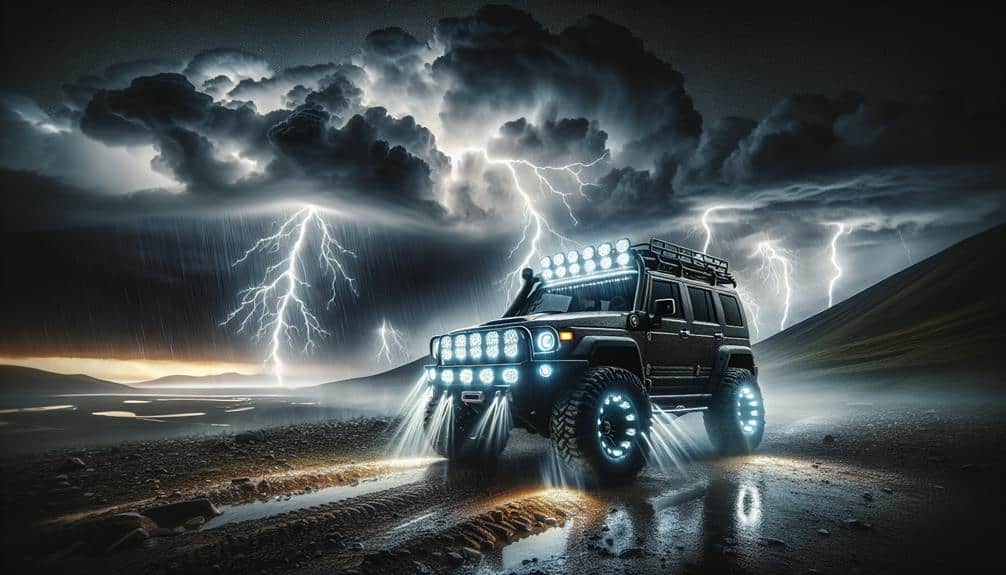
Underbody lights, often overlooked, are essential for improving nighttime visibility and safety by illuminating the ground beneath our SUVs, helping us navigate challenging terrains and spot potential hazards.
For storm chasers, this means more than just aesthetics; it’s about guaranteeing our rigs are ready to tackle any obstacle the darkness conceals.
When selecting underbody lights, customization is key. We can choose from a variety of color options to match or contrast our vehicle’s appearance, providing both functionality and flair.
RGB LED systems allow us to switch between colors, adapting to different environments or personal preferences.
Energy efficiency is another vital factor. LED underbody lights consume less power, preserving our SUV’s battery life during extended chases. Their longevity ensures we won’t need frequent replacements, which is important when every minute counts in storm tracking.
Frequently Asked Questions
How Can I Ensure My Lighting Setup Is Weatherproof?
To guarantee our lighting setup is weatherproof, we should use waterproofing techniques like sealing and gaskets, and choose durable materials such as polycarbonate lenses and aluminum housings. These steps will protect against harsh conditions and maintain performance.
What Are the Power Requirements for Exterior Lighting on Storm Chasing Suvs?
We need to weigh power consumption and energy efficiency when selecting exterior lighting. Proper wiring and installation techniques are vital to guarantee our setup operates at its best and doesn’t drain the SUV’s battery, maintaining our freedom to chase storms effectively.
Are There Any Legal Restrictions on Exterior Lighting for Vehicles?
We must consider lighting regulations and safety concerns when outfitting our vehicles. Local laws dictate allowable types and placements of lights to prevent blinding other drivers, ensuring our storm chasing adventures remain both legal and safe.
How Do I Mount Exterior Lights Securely on My Suv?
We guarantee secure exterior light mounting using robust brackets and clamps. For longevity and performance, we apply waterproofing methods like silicone sealant and rubber gaskets. These techniques guarantee our lights withstand severe weather conditions and enhance our storm chasing freedom.
What Maintenance Is Required for Long-Lasting Exterior Lighting?
Think of our exterior lights as the Excalibur of storm chasing; to maintain their longevity, we need a consistent cleaning routine and a strict replacement schedule. Weather sealing and regular wiring inspection are equally important for best performance.
